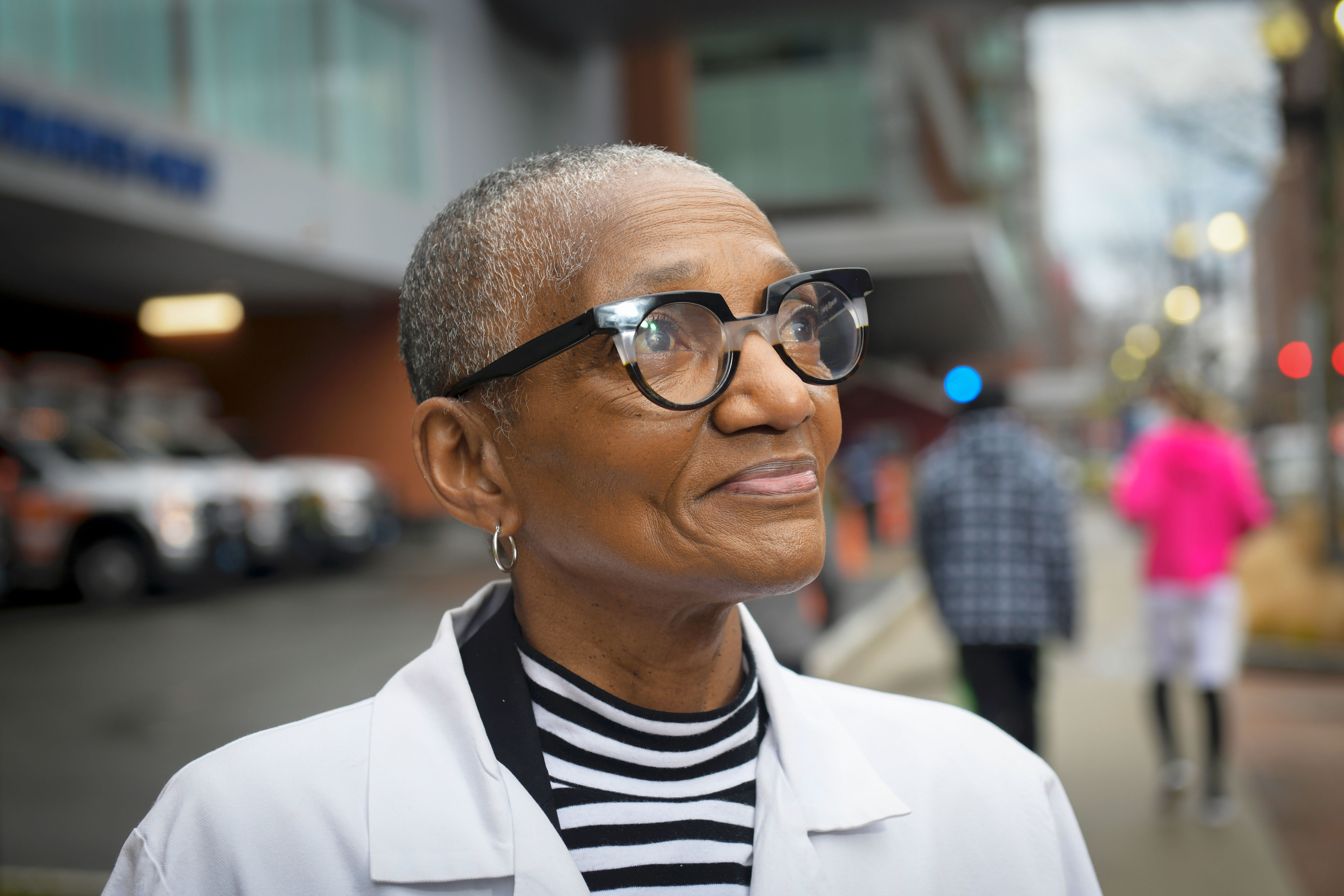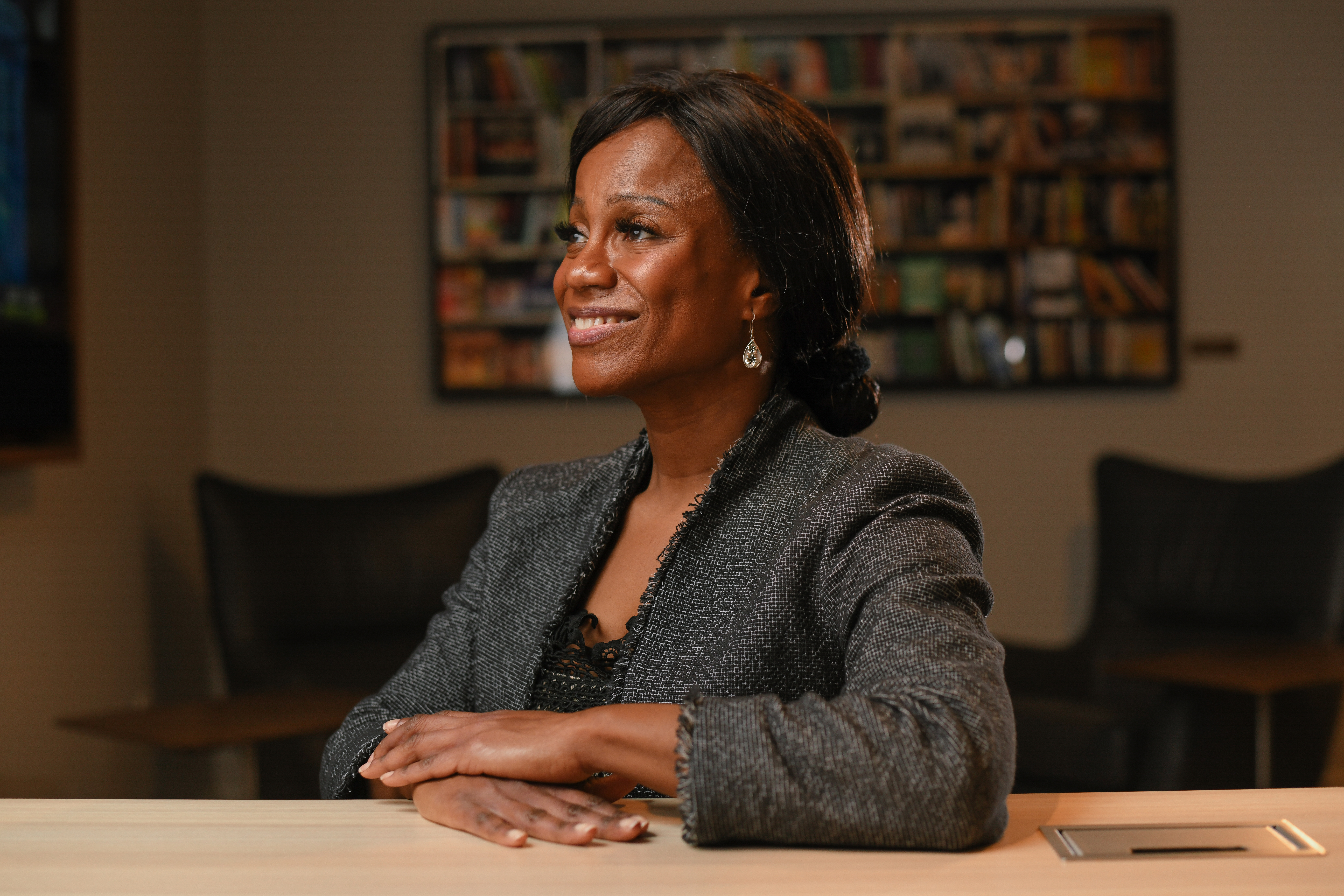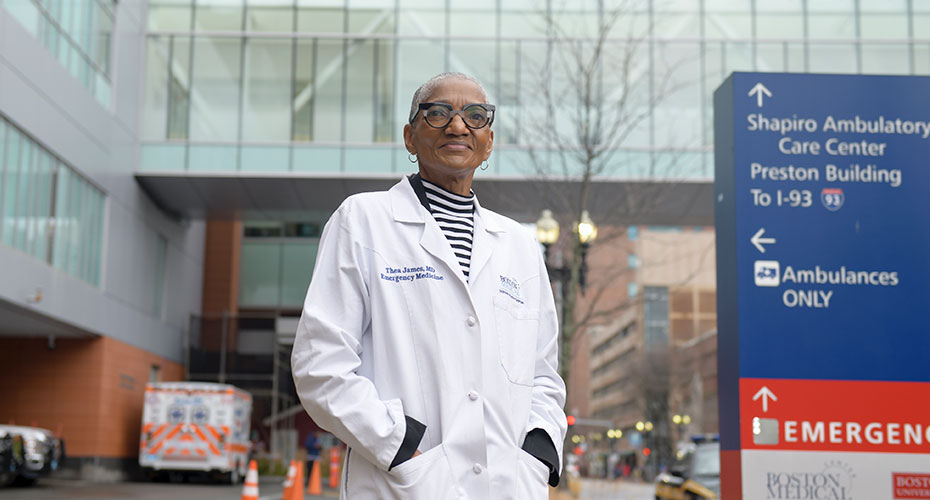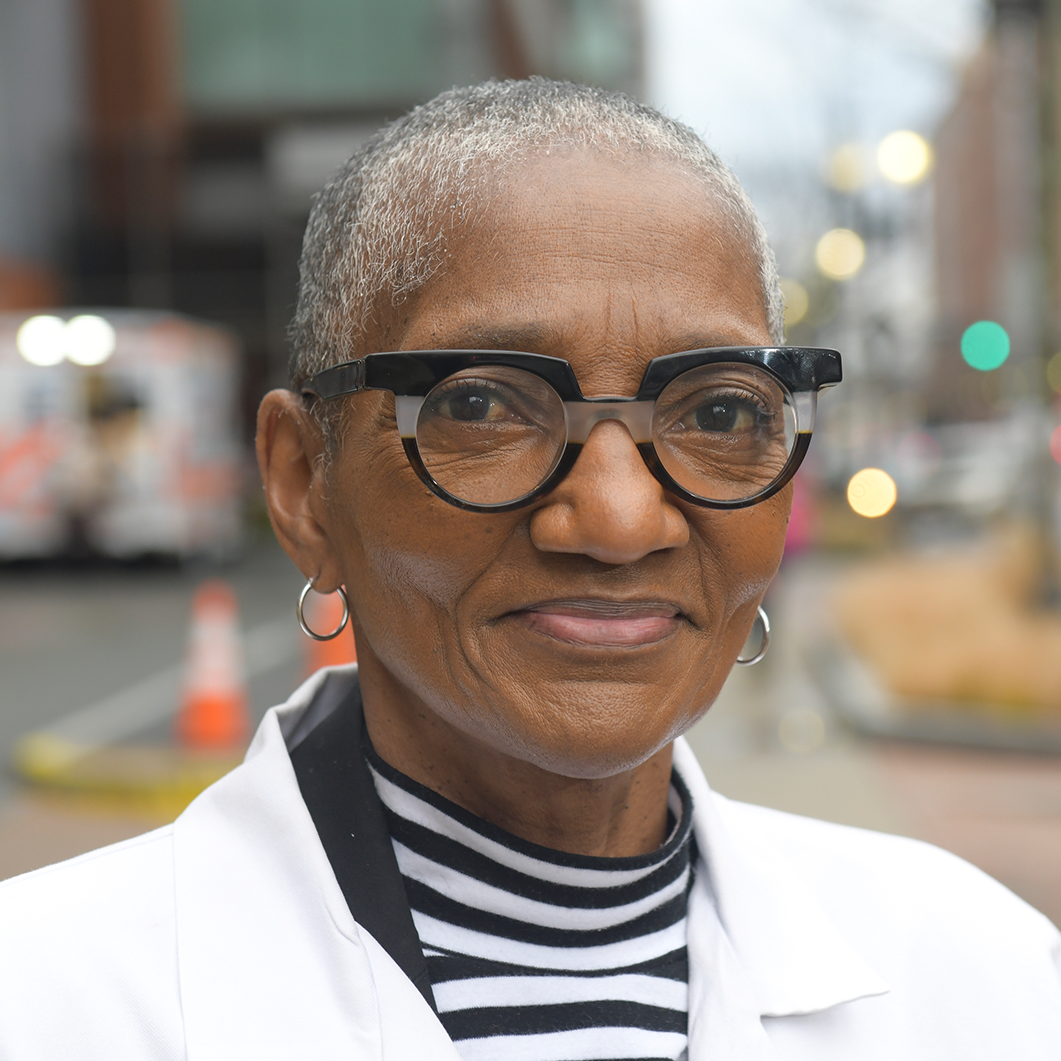Dec 20, 2021
‘It is not natural for people to choose suffering’
Coverage is proud to publish columns featuring the perspectives of Black women physicians who belong to the Diva Docs network in Greater Boston. Today, Dr. Thea James, emergency room physician, executive director of the Healthy Equity Accelerator, vice president of mission and associate chief medical officer at Boston Medical Center, shares her thoughts with Dr. Philomena Asante, leader of Diva Docs Boston, founder of the Diva Docs Black Women MD Network and creator of the Digital Health Award-winning Diva Docs series for Coverage.
I grew up in an African American community, in a working-class family. My dad worked for the post office and drove a taxi, and he was an entrepreneur – he owned a bowling alley in Washington, D.C. In the area where we lived, we saw Black people climbing. There were Black homeowners, Black federal employees, Black-owned businesses. It was very different from many other places in America. And my parents always made sure I knew the world was bigger than my community.
I was rebellious growing up. I’d get in trouble, particularly in high school. I got suspended all the time. It drove my parents nuts. I’ve always been different, curious, questioning and resisting everything that didn’t make sense to me.
I noticed everything as a child. At 9 years old, I started noticing the Black ladies at bus stops carrying bags, their feet and legs swollen, and I remember thinking, “My God, I don’t know what’s going on, but they’re suffering.”
My dad insisted I notice things as well. If I mentioned a cashier wasn’t pleasant, for instance, he would stop me in my tracks and say, “You don’t know anything about that person. You don’t know what their life is like. They may not have enough food. You have no right.” He held me accountable. That has served me well in medicine.
Path to the ER
My love of the ER began in college when I joined a pre-med club and shadowed a surgeon who took me to the operating room and to the emergency room where he moonlighted. I loved it. He was one of my first mentors. I chose the chair of our ER department as my mentor in residency, and since then I’ve found a network of Black ER doctors who have befriended and supported each other’s careers consistently over the years. We lift each other up. We’ve kept that pipeline going.
After college, I didn’t go to med school right away. I went to grad school, and worked in labs, and on the weekends, I worked a double shift as a phlebotomist in a hospital, on the trauma team. I absolutely loved it. It never felt like work, and I knew when I went to med school that I would do emergency medicine.
I saw the difference I could make as a Black doctor — the way a Black patient will look around a trauma room, see me, the one Black doctor, and lock their eyes on me. And they keep looking back to make sure I am still right there
From the start, I liked being a person who can shift a patient’s perspective just by being there, and by listening.
After 30 years in the emergency room, that is still one of the most important lessons I’ve learned: People want to be heard, and respected.
They want to be acknowledged when they are upset. They want an apology if they’ve been waiting. They want to be asked, “What do you need? What can we do for you?” And they want someone to listen to the answers.
The second thing I’ve learned is not to make any assumptions about people. Because you have no idea. You’re going to be wrong.
For instance, some nurses and doctors may assume the patients we see over and over in the ER don’t care about their health. But many of our patients are forced to make difficult decisions every day. “Do I use my limited money to pay for a prescription or transportation to a medical appointment, or for food or to keep the lights on and pay rent?” As a result, their health comes last, and they wind up at the hospital over and over again.
It is not natural for people to choose suffering. As a physician, my goal is to find out what caused that suffering, from their perspective.
I always ask my ER patients, “What would it take for this to never happen again?” And I always get good answers. My discharge planning is tailored to their response.

What if you or a loved one find yourself in the ER?

My spouse had breast cancer some years ago, and every Monday she would write a note to her entire care team telling them what her week was like, including the chair of the department. Not everyone needs to write a letter every week, but everyone should hold their doctors and nurses accountable. It’s one way of ensuring equity in care.
Innovation at BMC
At BMC, the more nuanced your approach to improving health care is, and the more innovative you are, the more likely you are to get support. It’s a bold, creative, collaborative culture. And we have an absolutely extraordinary CEO, Kate Walsh, who does not suffer fools, but will listen to anyone at any time.
We’re a safety net hospital. Three-quarters of our patients are government-insured. That fosters innovation. It means we have to find different ways to fund things. We have to find different ways to look at things.
For example, about 20 years ago, there was a resurgence of gun violence in Boston. Because more than 70% of the victims were being treated at BMC, we were given a grant for violence intervention. At the time, there were only three violence intervention hospital-based programs in the country. One program we read about used metrics like whether the person experienced reinjury or reincarceration or dropped out of school. We felt the bar was set too low.
Around the same time, in the trauma room I started noticing the tattoos on kids’ bodies: tattoos saying things like, “Born to be hated, dying to be loved.” Or, “Living is hard, dying is easy.” Or, “Death is nothing, but to live defeated is to die every day.” I realized, “Oh my God, people think these kids are monsters. Actually, they are hopeless.”
So when we created our violence-intervention advocacy program, we had high hopes and we set high bars, because where you set the bar will become a self-fulfilling prophecy.
Our program asks: Why can’t these kids achieve? Why can’t they earn college degrees and certifications? Why can’t they be homeowners?
Why can’t these kids have the options that we have?
We started the program with two people and now it engages about 400 victims of violence a year. We are a founding member of the Health Alliance for Violence Intervention, which has set a national standard for violence intervention.

Combating inequity
In Boston, we have some of the best health care institutions in the world. But we also have stark inequity. One study found the median net worth of the average white family here is $247,000 and for the average non-immigrant Black family, it’s $8. That’s the legacy of decades of redlining, and centuries of structural racism that have impeded generational wealth-building.
The effect on health is entirely predictable. We know health data will almost always show poorer outcomes for Black and Brown people than for white people.
At BMC, we want to change those structures and patterns. As vice president of mission, I’m primarily responsible for BMC’s strategic relationships and alliances. Our goal is to move away from charity or subsidies to changing the life-course trajectory of our patients.
We are reimagining our investments in people with the expectation that they will have the opportunity to achieve at their fullest potential.
People can become financially stable and self-sufficient. They can build multigenerational wealth. They can contribute to this economy versus relying on it to take care of them.
For instance, we know housing and employment can change the trajectory of lives, but we also know there are poverty traps built into many systems. If you get subsidized public housing, you can only earn so much money to keep your housing. That forces people to turn down better jobs and raises and promotions because they don’t want to lose their home, especially in a region where there is so little affordable housing. So we’re working with the Boston Housing Authority and with an organization that uses the federal Family Self-Sufficiency Policy. Under this policy, eligible residents can earn more money, and the overage goes into escrow for homeownership, education, buying a business or other goals. It can change their trajectory.
We also invest in housing development in alignment with our goals, such as Bartlett Station, which will have 323 units of mixed-income housing. Developer proposals for that site had to include access to employment, to green walking space, transit, and healthy, affordable food.
BMC’s new Health Equity Accelerator
This fall, we launched a new effort to make health care equitable for people of color, our Health Equity Accelerator.
We are committed to a transformation — not an initiative or project, but a transformation in the way we work.
We are starting by examining ourselves. We reviewed data across our entire enterprise, scanning for disparities in outcomes, policies, and procedures and interrogating them for potential inequities that may have inadvertently contributed to creating those disparities. One of the first things we found was a big difference in postpartum hemorrhage between Black and white women. We dug in our data for root causes and found 75% of the Black women who had postpartum hemorrhage had preeclampsia. Delivering the baby is the definitive treatment for preeclampsia and rates of postpartum hemorrhage are correlated with delays in c-section. We found longer delays for Black patients. We are going deeper, looking at whether there are communication barriers, trust barriers with clinicians, unconscious bias, as well as other issues.
As we address inequity, I always ask: How is what we are proposing different than what we have done previously? What inequity will this address and how will it affect outcomes? That level of accountability requires discipline in our mindset.
We should be able to get to a point where data is not as predictable as it is now, where outcomes are not predictable by race, and where people are enabled to reach their full potential. The only way you do that is to have an intentionality to make meaningful change. Everybody benefits from that. Everybody.
PHOTOS BY FAITH NINIVAGGI.

